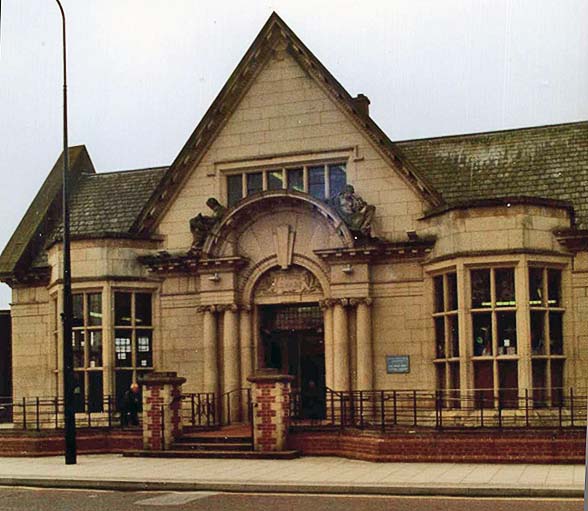Local Carnegie Libraries

Following the sale of his assets in 1901 to J P Morgan at the age of 65, the Scottish steel magnate
Andrew Carnegie – thought at that time to be the richest man in the world – decided that the moral
obligation of his life would be to help others, so under the principle of ‘The Gospel of Wealth’ over
time he gave away $350 million. One significant aspect of this was the setting up of libraries, the first
one being in his birthplace Dunfermline in 1883 with ‘Let there be light’ above the front entrance. In
subsequent years Carnegie libraries were opened throughout America and the world, over 2500
being built between 1883 and 1929. The first Carnegie library in Britain was in Keighley in 1899.
It fell as the responsibility of towns to request Carnegie funding and the vast majority that did so
were accepted at a time when libraries were becoming popular as a means of moral and self-help as
well as in the education of the poor. Rochdale had seen the importance of libraries from the 1850’s
when local commissioners, backed by Rochdale ‘gentlemen,’ considered making a gift towards a free
library for the townsfolk although such was the stalemate in local government, the call was still
being made in the 1870’s ! However, the Public Libraries Act of 1850 gave local boroughs the power
to make free libraries and with a thousand Rochdale signatures, a library was opened on the second
floor of the Town Hall in 1872.

There was, however, little or no early library provision in villages and small towns outside of
Rochdale. A Carnegie bequest was an answer to this and in the early years of the 20 th century
applications for funding were made to the Carnegie United Kingdom Trust. The stipulation was that
funding would cover construction only, local committees having to finance books, maintenance and
repair of buildings, a reason for some authorities turning down the opportunity. In applying, proof
was required that there was a local need for a free library service, a site for construction and an
ability to both pay staff and maintain the building. These points were met locally and requests came
forward to the Library Committee to apply for Carnegie funding from three local councils – Milnrow,
Castleton and Heywood.

In Castleton there had been a small branch library at a house in Emma Street in 1901 but following
an application by the Chair of the Committee, Colonel Fishwick, a grant from Carnegie of £2500 was
made towards a building which subsequently opened on Manchester Road in 1905, a gold key
presented to the Mayor at the ceremony. Designed by Jesse Horsfall, the library was built with
Accrington brick and Staffordshire roof tiles and held 10,000 volumes. The building served as a local
library until 2007 but due to the need for extensive repairs has been superseded as a library by the
community centre. The original building still stands however, having at one time been a holistic
health centre. It is currently under refurbishment.

Milnrow also made a successful request in 1902 for Carnegie funding of £2500 and is now a listed
building in the village, being of historic and architectural interest. Designed by Butterworth and
Duncan of Rochdale (who also designed libraries at Littleborough, Wardle and Clitheroe) it combines
both Arts and Crafts and Art Nouveau influences. The building was opened on July 4 th 1908 and then
as now, the library has a central borrower’s hall and a reading room. The ‘ladies room’ (now an IT-
suite) and the ‘boys room’ have become part of the general library. A first floor lecture room with its
barrel-vaulted ceiling is an impressive space albeit currently rather underused. Dry rot threatened
the library in 1999 to such an extent that Councillors commented that it might have to be
demolished. However, funding was found for renewal of the buildings after much concern from the
public and the council.

A bequest application to the Carnegie Fund was successful in time for Heywood Library to be built
and opened on 17 th March 1906 by the Lord Mayor. Replacing an old library which had been opened
in 1874, the Carnegie-funded public library stands on Church Street. At a cost of £6709 and built of
Darley Dale stone with three columns over the entrance, it originally had space for an adult lending
library, a junior library, a reference library and a reading room.
In providing the funding for libraries, Andrew Carnegie bequeathed a world-wide legacy for the
whole of society but especially for its young people. The marvellous buildings which are left to us
reflected a time when architecture, learning and art went hand in hand and it should be sincerely
hoped that such aspirations continue with our policy makers in order to protect both our beautiful
architectural heritage as well as the desire for knowledge free at the point of need.